#Code Orange Ozone Alert
Explore tagged Tumblr posts
Text
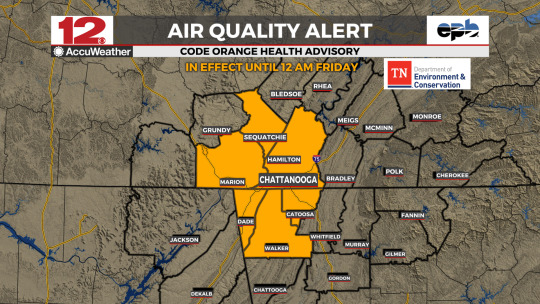
#WDEFWeather #News12Weather: Thanks to our stagnant atmosphere with increasing #ozonepollution, the #CodeOrange #AirQualityAlert for the #ChattanoogaTN area counties has been extended through Thursday.
Details tonight on @WDEFNews12
#chattanooga weather#chief meteorologist austen onek#tennessee river valley#wdef-tv#[email protected]#wdef.com/weather#wdef chattanooga#wdef news 12#wdef#wdef.com#Code Orange Air Alert#Code Orange Health Advisory#Code Orange Ozone Alert#Tennessee Department of Environment and Conservation#Ozone Pollution#Poor Air Quality#Chattanooga Tennessee#Chattanooga Air Quality#Chattanooga TN
0 notes
Text
Why you're coughing more today: Atlanta's high ozone alert
Atlanta has a "code orange" air quality alert today due to high ozone concentration, a chemical reaction between sunlight, oxygen, & pollution from cars, power plants, factories, etc.
(Sounds like car traffic makes it harder for pedestrians to breathe)
People in sensitive groups, such as asthma sufferers, may experience watering eyes, coughing, throat irritation, chest pain, and breathing difficulty. Try to limit your time outside, especially in the middle of the day.
Also, let's please stop polluting the air so much. How? From the EPA website:
"On Days when High Ozone Levels are Expected, Take these Extra Steps to Reduce Pollution:
> Choose a cleaner commute - share a ride to work or use public transportation.
> Combine errands and reduce trips. Walk to errands when possible.
> Avoid excessive idling of your automobile.
> Refuel your car in the evening when its cooler.
> Conserve electricity and set air conditioners no lower than 78 degrees.
> Defer lawn and gardening chores that use gasoline-powered equipment, or wait until evening."
Good tips. Notice that several of them revolve around cars.
Personally, I also recommend that the world focus on multifamily housing for the long run, which I'm committed to for several reasons, including the lessened burden on energy (shared walls = less AC/heating energy needed) and lessened burden from lawn-care pollution, and the way that density supports public transit.
[High horse dismounted. Good horse. Goooood horse.]
11 notes
·
View notes
Text
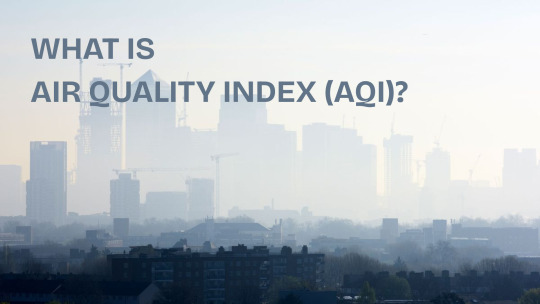
Unaware about AQI? Let's discuss what it is and how it helps.
The rising level of air pollution is a serious concern all over the world. An increasing number of vehicles on the road, deforestation, and increasing pollution are some of the main reasons for excessive amount of pollution. The Air Quality Index (AQI) is a standardized tool used worldwide to communicate the level of air pollution in a clear, concise manner. This tool helps authorities to take necessary measures and simplify complex air pollution data into a single, easy-to-understand number and description.
How does it work?
AQI converts complex air quality data into a single number, colour, and category that helps the public understand the health implications of outdoor air conditions.
Key Purposes of the AQI:
To inform the public about short-term air quality.
To provide health advisories, especially for sensitive groups (children, the elderly, those with respiratory diseases).
To aid government and health agencies in making public safety decisions (e.g., restricting outdoor activities during smog events).
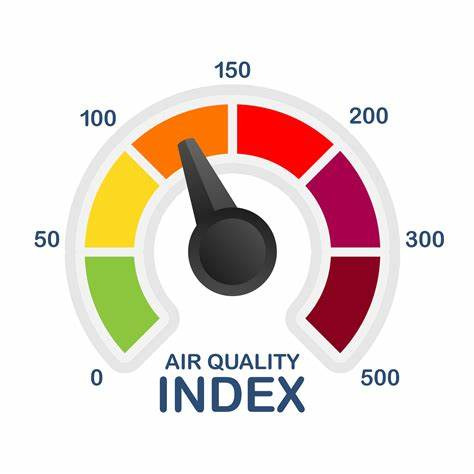
Pollutants Measured in AQI
The AQI typically measures major air pollutants that can harm human health and the environment. These include:
Particulate Matter (PM2.5 and PM10): Tiny particles suspended in the air that can penetrate deep into the lungs and bloodstream.
Ground-level Ozone (O₃): A harmful gas formed when sunlight reacts with pollutants from vehicles and industry.
Nitrogen Dioxide (NO₂): A gas produced from combustion processes, especially in traffic-heavy areas.
Sulfur Dioxide (SO₂): A gas released by burning fossil fuels, especially in power plants and industries.
Carbon Monoxide (CO): A colorless, odorless gas formed from the incomplete combustion of carbon-based fuels.
Each pollutant's concentration is converted into an individual sub-index based on standardized breakpoints. The highest sub-index among all pollutants determines the overall AQI for the location.
This AQI is then generally categorized into six levels, each with a color code and associated health advice:
0–50 (Good, Green): Air quality is ideal.
51–100 (Moderate, Yellow): Acceptable, may affect sensitive individuals.
101–150 (Unhealthy for Sensitive Groups, Orange): Risk to people with heart/lung conditions, children, and the elderly.
151–200 (Unhealthy, Red): The General public may begin to experience health effects.
201–300 (Very Unhealthy, Purple): Health alert; everyone may experience more serious effects.
301–500 (Hazardous, Maroon): Emergency conditions; health warnings of emergency nature.
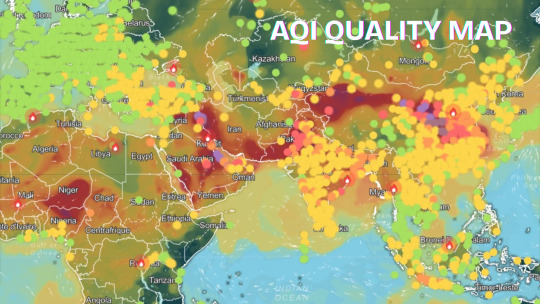
How did it help?
AQI frameworks are broadly similar across nations but differ in pollutants tracked and how data is communicated. Based on AQI monitoring and air quality management, various cities have improved their AQI. Some examples are Los Angeles (USA), London (UK), Beijing (China), Mexico City (Mexico), Istanbul (Turkey) & Seoul (South Korea). Let’s discuss briefly how they improved.
Los Angeles, USA
Once notorious for smog, LA has seen significant air quality improvements due to strict emissions standards, vehicle regulations, and industrial controls.
Continued investment in electric vehicles and green infrastructure is helping reduce ozone and PM2.5 levels.
London, UK
In the 1950s, London experienced deadly smog events (like the 1952 Great Smog) due to coal burning, which improved through the Clean Air Act, Ultra Low Emission Zones (ULEZ).
By investing in public transport and cycling infrastructure, AQI has improved dramatically, and NO₂ levels in central London have decreased by over 40% in recent years.
Beijing, China
It was known for hazardous smog episodes in the 2000s and early 2010s. After implementing the Air Pollution Prevention and Control Action Plan (2013), Beijing’s average PM2.5 levels fell by more than 50% between 2013 and 2021.
Strict industrial regulations significantly improved the air quality, particularly during winter when coal use was previously high.
Mexico City, Mexico
Mexico City was once dubbed “the most polluted city on Earth” by the UN in the 1990s. The government banned leaded gasoline, restricted car use via the “Hoy No Circula” program, and invested in public transit, due to which the AQI has improved notably, with fewer extreme pollution days.
Seoul, South Korea
Seoul faced high PM2.5 levels due to traffic and transboundary pollution from China. Government measures include banning diesel cars on high-pollution days, reducing coal power generation, and promoting electric vehicles, which have gradually but measurably improved the AQI, particularly in urban zones.
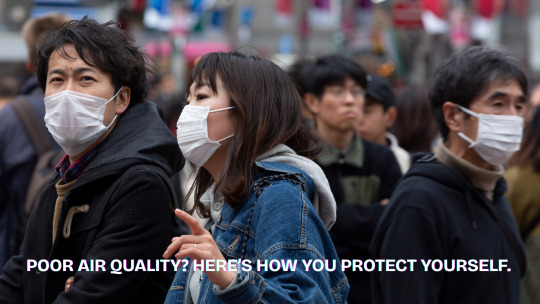
What Can You Do About It?
Responding effectively to poor Air Quality Index (AQI) days is important for protecting your health—especially if you belong to sensitive groups like children, the elderly, or those with respiratory or heart conditions
Recently, dust storms have hit Kuwait, Iraq, and Saudi Arabia, making the air very unhealthy to breathe. In Kuwait, the air quality index (AQI) in Al Ahmadi reached 538 and 502 in Al Qurain, both considered hazardous levels as a result.
This high AQI is the result of dust and tiny particles in the air, which can be very harmful, especially for people with breathing problems, older adults, and children. Health officials are likely telling people to stay indoors as much as possible until the air improves.
Here are some steps to take when the AQI is poor:
1. Stay Indoors When Possible
Limit outdoor activities, especially strenuous exercise.
Keep windows and doors closed to prevent polluted air from entering.
2. Use Air Purifiers
Use a HEPA air purifier indoors, particularly in bedrooms.
Avoid using air fresheners, candles, or incense that can worsen indoor air.
3. Wear a Mask Outdoors
N95 or KN95 masks can filter out fine particles like PM2.5.
Surgical and cloth masks are not effective for air pollution.
4. Monitor Air Quality in Real Time
“Respirer Living Solutions” works towards monitoring and management of air quality, empowering people to be aware.
Use local government AQI sites to stay updated.
Plan outdoor time during hours when pollution is lower (typically early morning or after rain).
5. Create a Clean Air Zone at Home
Designate one room with:
An air purifier,
Sealed windows,
No indoor pollutants like smoking or cooking with gas.
6. Avoid Activities That Worsen Indoor Air
Don’t vacuum or smoke indoors.
Limit frying or high-heat cooking unless ventilation is excellent.
7. Use Public Transit or Carpool
Reduce your contribution to air pollution by using greener transport options.
8. Stay Hydrated and Watch for Symptoms
Pollution can dehydrate your respiratory tract.
Watch for coughing, shortness of breath, headaches, or fatigue—seek medical attention if symptoms worsen.
Conclusion
Air pollution is a growing global concern, but tools like the Air Quality Index (AQI) help us understand and respond to the risks. Cities like Los Angeles, Beijing, and London show that progress is possible with strong policies and public cooperation. At the same time, many regions still face serious challenges. To help and be aware of the air quality, “Respirer Living Sciences” has created air quality monitoring and management solutions.
By staying informed, protecting ourselves on poor AQI days, and making eco-friendly choices, we can all play a part in improving air quality. Clean air is essential—and it’s up to all of us to help protect it.
#climate change#city#healthcare#airpollutants#air quality#clean air#AQI#respirer living sciences#pm2.5#co2#air pollution
1 note
·
View note
Link
Excerpt:
The destructive wildfires that continue to burn thousands of acres across California have created an air pollution nightmare for millions of residents on the West Coast. Smoke pouring from 20 active wildfires has prompted officials to issue air-quality alerts in several states.
The wildfires are emitting vast amounts of smoke full of a toxic mixture of gases and fine particles that come from burning wood and plant material. When inhaled, the microscopic particles can quickly move to the lungs and bloodstream, increasing the risk of developing asthma and other respiratory problems.
In addition to the dangerous particulate matter, the toxic combination of gases in smoke clouds provide a perfect breeding ground for the formation of surface-based ozone, which can result in negative health effects in its own right.
In many areas Tuesday, the air quality reached Code Orange levels, translating to unhealthy conditions for sensitive groups such as young children, older adults and those with respiratory problems. But there were also sizable pockets of Code Red and even Code Purple conditions, meaning unhealthy to very unhealthy air for all populations.
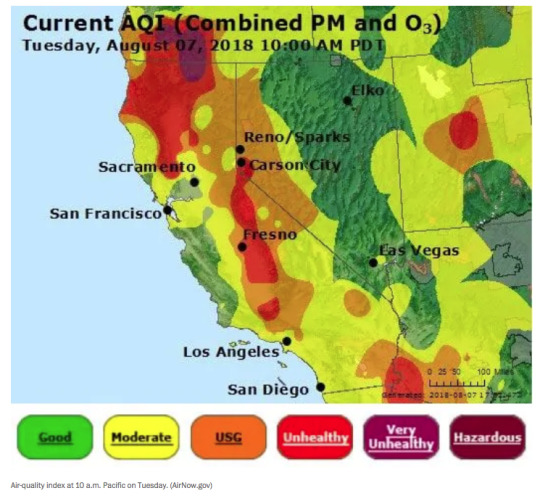
4 notes
·
View notes
Text
China To Deploy World’s Biggest Air Purifier In Beijing To Fight Heavy Smog
China will deploy the world’s largest outdoor air purifier designed by a Dutch engineer in its smog-hit capital Beijing, as the thick heavily-polluted haze returned to haunt the city, driving people indoors. The seven-meter-tall tower, brainchild of Dutch designer Daan Roosegaarde, is undergoing last-minute checks in Beijing’s 751 D Park art area.
The ‘Smog Free Tower’ will soon be opened to the public, and will be toured across the country, state-run Global Times said, quoting China Forum of Environmental Journalists, an NGO under China’s Ministry of Environmental Protection.
The tower can capture about 75 per cent of Particulate Matter 2.5 (PM 2.5) and Particulate Matter 10 (PM 10) tiny particles in its vicinity and then release purified air to create a “bubble” of fresh air around it. The tower can clean 30,000 cubic meters of air per hour through its patented ozone-free ion technology.
Beijing has been plagued with heavy smog since the beginning of October. The city’s environmental authorities issued a “yellow alert” for air pollution on Tuesday. “Yellow alert” is the third-most serious level in a four tier colour-code warning system. Red is the most serious and orange the second-most serious while blue is the least serious pollution level.
The average PM2.5 density of the small deadly polluted particles crossed over 300 today even though a cold front in the morning cleared the smog a bit. Liu Guozheng, CFEJ secretary-general said the tower is intended to warn authorities never to forget their duty and encourage the public to pull together to combat the smog.
The public, meanwhile, are bemused by the tower’s function and have called on authorities to curb dangerous sources of polluting particles, the daily said. Netizens expressed their frustration over the tower.
“The so-called divine smog cleaner is more like a piece of performance art, which makes almost zero difference to cleaner air in the city. It devours the polluted air and exhales fresh air, but so little it won’t make any difference. The air will stay polluted,” the daily quoted a comment by Sina Weibo user.
Source: China To Deploy World’s Biggest Air Purifier In Beijing To Fight Heavy Smog
0 notes
Text
Beijing to have world’s biggest air purifier to fight smog

China will deploy world’s largest outdoor air purifier designed by a Dutch engineer in its smog-hit capital Beijing, as the thick heavily-polluted haze returned to haunt the city, driving people indoors. The seven-meter-tall tower, brainchild of Dutch designer Daan Roosegaarde, is undergoing last-minute checks in Beijing’s 751 D Park art area. The ‘Smog Free Tower’ will soon be opened to the public, and will be toured across the country, state-run Global Times said, quoting China Forum of Environmental Journalists, an NGO under China’s Ministry of Environmental Protection.
The tower can capture about 75 per cent of PM 2.5 and PM 10 tiny particles in its vicinity and then release purified air to create a “bubble” of fresh air around it. The tower can clean 30,000 cubic meters of air per hour through its patented ozone-free ion technology. Beijing has been plagued with heavy smog since the beginning of October. The city’s environmental authorities issued a “yellow alert” for air pollution on Tuesday.
“Yellow alert” is the third-most serious level in a four tier colour-code warning system. Red is the most serious and orange the second-most serious while blue is the least serious pollution level.
The average PM2.5 density of the small deadly polluted particles crossed over 300 today even though a cold front in the morning cleared the smog a bit. Liu Guozheng, CFEJ secretary-general said the tower is intended to warn authorities never to forget their duty and encourage the public to pull together to combat the smog.
The public, meanwhile, are bemused by the tower’s function and have called on authorities to curb dangerous sources of polluting particles, the daily said.
Netizens expressed their frustration over the tower. “The so-called divine smog cleaner is more like a piece of performance art, which makes almost zero difference to cleaner air in the city. It devours the polluted air and exhales fresh air, but so little it won’t make any difference. The air will stay polluted,” the daily quoted a comment by Sina Weibo user.
Source: Beijing to have world’s biggest air purifier to fight smog
0 notes
Text
HOW TO IMPROVE AIR QUALITY AT YOUR CHILD’S SCHOOL
A healthy, resting adult takes 12 to 20 breaths per minute.
Children, from school-age to preschoolers and younger, take many more. It’s normal for a toddler to take twice as many breaths as an adult, and an infant may take a full three times more.
Every breath matters, especially for their developing lungs, but more than a third of all Americans live in communities where air quality does not meet national standards for ozone or other air pollutants, according to 2017 data from the Environmental Protection Agency. In addition, the EPA reports that half of the 115,000 schools in the United States have problems linked to indoor air quality. Considering that more than 6 million American children have asthma, these air quality problems are especially worrisome.
How can parents and teachers help children breathe easier? Here’s what you need to know about air quality in and around schools, and what you can do to improve it.
INDOORS
Almost 55 million students and 7 million staff members spend their days in school facilities across the country. If you and your loved ones are among them, you might be inhaling a host of indoor pollutants, including PCBs, asbestos, volatile irritant chemicals from cleaning products, radon, and even mold. In addition to triggering health problems such as headaches and asthma, poor indoor air quality can result in lower school grades and more days missed due to sickness.
The good news: Administrators, teachers and families have tools to improve indoor air quality in schools. Many of these tools are similar to those you may use in your own home. The EPA offers an Indoor Air Quality Tools for Schools Action Kit that provides guidelines, best practices, sample policies and a sample management plan. Areas to focus on include improving HVAC systems, maintaining filters and carbon monoxide detectors, controlling moisture and mold, managing pests, and carefully selecting cleaning and building materials.
The EPA does not require schools to monitor their air quality, submit information about it or use these voluntary tools, so it’s important for parents to speak up. Share the action kit with your school and talk to decision makers about what they’re doing to improve indoor air quality. Here are additional recommendations for parents, particularly those whose children suffer from asthma.
Some states and school districts have specific policies or regulations to improve indoor air quality. To learn about your area, visit the Environmental Law Institute’s database of state indoor air quality laws.
OUTDOORS
When students step outside school buildings for fresh air, that air might not be so fresh. Pollutants such as smoke, road dust, car exhaust and factory emissions can all add up to poor quality air. And some days are better than others.
How can you tell the difference? Check your local Air Quality Index. The daily index reports how polluted your air is and what it means for your health. Among other pollutants, the index tests for the two most hazardous types of air pollution: ground-level ozone, or smog, and airborne particles.
Children are particularly sensitive to air pollution, so when air quality is rated orange – “unhealthy for sensitive groups” – it might be wise to limit prolonged periods outdoors and avoid heavy exertion, including outdoor sports.
Some school districts adjust recess and outdoor play based on air quality. Ask your children’s school about its air quality policies and share the EPA’s Air Quality Index Toolkit for Teachers. To find your Air Quality Index, search by zip code on AirNow.com, sign up for email alerts on EnviroFlash.info, or check local weather reports on television or in the newspaper. Do you see buses idling outside your children’s school? Diesel exhaust can damage lungs, irritate eyes and throats, and trigger asthma or allergies, so check out these tips and tools for reducing bus idling. These resources are designed not just for schools, but for students, parents and community members, as well. Talk to your kids about why air quality matters and encourage them to get involved, too. Read more
Related Post
The Hidden Toxins In Your Clothing
Toxin Cleanse: Which Toxins Are Disrupting Your Health?
Where to Find Natural “Green” Building Materials
10 Shocking Facts About Indoor Air Quality
from WordPress https://ift.tt/2ua02vj via IFTTT
0 notes
Text
I Just Received Notice of an Air Quality Advisory in My Area. Now What?
During the blazing days of summer, local television and radio commentators will often announce a local Air Quality Advisory, cautioning people to remain indoors if possible as the air is dangerously polluted.
Do you know what causes an air quality alert, and what it means for you and your family?
An Air Quality Advisory is a warning that air pollution levels are high. Several things contribute to air pollution such as carbon monoxide, sulfur dioxide, nitrogen dioxide, and lead, but the two most significant threats to public health are:
Tropospheric Ozone – Often called ground-level ozone, pollutants such as car mixing with oxygen create this effect. The most dangerous levels occur during the afternoon and early evening on hot summer days. This type of air pollution can trigger asthma attacks decreasing lung function and make it difficult for you to breathe.
Particle Matter – forms year-round and consists of dust, smoke, soot, and ash. It is often caused by burning fossil fuels and is most common on hot, humid days. Limit your time outdoors as the particulate matter in the air can make you cough or feel sick.
The Air Quality Index
There are also different air quality alert codes. The Air Quality Index (AQI) reports daily air quality. The index advises you of how polluted the air is and the health effects that might concern you. The Environmental Protection Agency (EPA) established national air quality standards and calculates the AQI for the air pollutants regulated by the Clean Air Act.
The EPA uses a color-coded system, assigning a different color to each AQI category. Color-coding makes it easier for the public to visualize when air pollution has reached unhealthy levels, and what the effects might be when you reach a certain color level.
They are:
Green –air pollution poses no risk.
Yellow – air pollution is moderate and may affect those with sensitivities to a particular pollutant.
Orange – the air is unhealthy for sensitive groups such as those living with asthma or the elderly and young children.
Red – is unhealthy for everyone. The general population would experience some health effects, and sensitive groups would suffer severe consequences.
Purple and Maroon – is rare, but also extremely dangerous for the entire population.
So, What Should You Do When an Air Advisory Occurs?
If you hear an air advisory, reduce exposure by staying indoors with the windows tightly shut.
If you do venture outside, limit your time outdoors, and restrict strenuous activities. Keep windows in your car closed to avoid exposure to pollutants. Consider wearing a face mask, especially if you are doing yard work or other activities where you are exposed to additional allergens.
If you have asthma, always keep your rescue inhaler with you and take any preventative medicines prescribed by your physician.
Stay hydrated and breathe properly. Breathe through your nose, because it is the nose’s job to filter the air. You bypass this filtration system when you breathe through your mouth.
Invest in an air purifier. Even indoors, although the air may look clean, it can be saturated with microbes and dust particles. These microscopic air particles enter your lungs and throat, aggravating respiratory issues like asthma and COPD.
Air quality varies around the United States. Ozone, for instance, can pose a significant problem for those living with asthma and is more prevalent in urban areas. Visit airnow.gov, a website developed by federal, state and local agencies to monitor air quality. You can also download their app. The EPA also has a feature on its website called My Environment, which provides you with an air-quality forecast for your zip code.
What Can You Do to Keep the Air Cleaner?
There are lots of things you can to that will help reduce air pollution and keep the air we breathe cleaner, not only on an Air Advisory Day but every day!
Set the thermostat higher in the summer and lower in the winter to conserve energy.
Turn off the car when stopped. Idling a vehicle creates more pollution and uses more gas.
Turn off appliances you aren’t using. Saving energy means power plants will emit less pollution because they don’t have to produce as much electricity.
Plant trees and other vegetation because they keep the air clean through photosynthesis.
Combine errands in one trip, rather than several, so you have fewer cold starts with your vehicle.
Avoid using aerosol cans because they may contain volatile organic compounds which are an air pollutant.
Purchase energy efficient bulbs and appliances by looking for the Energy Star label.
Carpool, walk or bike whenever possible.
Always purchase green whenever possible. Buy environmentally-safe paints and cleaning products.
The post I Just Received Notice of an Air Quality Advisory in My Area. Now What? appeared first on Snoring HQ.
0 notes
Text
Air Quality Alert (Code Orange) / Tuesday, August 28, 2018
Air Quality Alert (Code Orange) / Tuesday, August 28, 2018 This is an important message from the District of Columbia AlertDC system. National Weather Service (NWS) reports an Air Quality Alert is in effect for Tuesday, August 28, 2018.The Metropolitan Washington Council of Governments in association with Maryland Department of the Environment, Virginia Department of Environmental Quality, and District Department of Environment has issued a Code ORANGE Air Quality Alert for the DC metro area.A Code Orange Air Quality Alert means that air pollution concentrations within the region may become unhealthy for sensitive groups. Sensitive groups include children, people suffering from asthma, heart disease or other lung diseases and the elderly. The effects of air pollution can be minimized by avoiding strenuous activity or exercise outdoors.For more information on ground-level ozone and fine particles, visit http://bit.ly/2srOKTi Click Here to update your profile.
0 notes
Text
Ware Mechanical Weather Center: Smog Alert for Bartow, metro Atlanta. Sunny and warm for Mother's Day weekend with highs in the low 90s.
Ware Mechanical Weather Center: Smog Alert for Bartow, metro Atlanta. Sunny and warm for Mother’s Day weekend with highs in the low 90s.
OUTLOOK
The Georgia Department of Natural Resources, Environmental Protection Division has issued a Code Orange (Unhealthy for sensitive groups) Air Quality Alert for Atlanta for Saturday May 12. Under Code Orange conditions, the outdoor air quality is likely to be unhealthy for some people. Children, people who are sensitive to ozone, and people with heart or lung disease should limit…
View On WordPress
0 notes
Text
Dallas-Fort Worth Ozone Alert Day – Saturday April 28
The Texas Commission on Environmental Quality (TCEQ) has issued an Ozone Action Day for the Dallas-Fort Worth area for Saturday, April 28, 2018.
Ozone Alert/Action Day – Orange Level
Ozone season begins in March and lasts through November. An ozone alert is issued every time the ozone level increases on the ground. So, what is ozone? It’s a gas that occurs in the upper atmosphere and at times on ground level. It’s good to have in the upper atmosphere because it protects the Earth from the sun’s harmful ultraviolet rays. It’s bad at ground level because it’s the main ingredient of urban smog and can be harmful to breathe.
Here’s why paying attention to the ozone level matters:
What happens when you breathe it?Breathing ozone can cause an array of issues including chest pain, coughing, throat irritation and congestion. It can worsen bronchitis, emphysema and asthma.
Who’s vulnerable?Ozone is a general human health threat, but those most vulnerable are children, the elderly, people with respiratory issues and people who work outside.
How can you prevent it?The best thing you can do on an Ozone Alert Day is to use public transportation to lower emissions, combine errands and reduce trips, and reduce outdoor activity that could exhaust you.
Below is a graphic of the color-coded ozone alert system that explains the Air Quality Index featuring Arlo the airmadillo.
Ozone Air Quality Index Graphic
OZONE AIR QUALITY INDEX GRAPHIC
For more information about Ozone, following the Department of Environmental Quality’s social media pages on Facebook and Twitter. To sign up for air pollution alerts, visit airnorthtexas.org.
The post Dallas-Fort Worth Ozone Alert Day – Saturday April 28 appeared first on Dallas City News.
Source: http://www.dallascitynews.net/dallas-fort-worth-ozone-alert-day-saturday-april-28
0 notes
Text
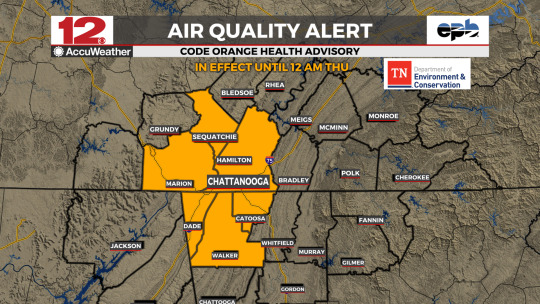
#WDEFWeather #News12Weather -- The #CodeOrangeHealthAdvisory has been continued through Wednesday for the Chattanooga metropolitan area counties for higher levels of ozone with our current stagnant atmosphere pattern.
#chief meteorologist austen onek#chattanooga weather#tennessee river valley#wdef-tv#[email protected]#wdef.com/weather#wdef#wdef chattanooga#wdef news 12#wdef.com#Code Orange Health Advisory#Code Orange Ozone Alert#High Ozone Levels#Tennessee Department of Environment and Conservation#Air Quality Alert
0 notes
Text
DEP Issues Code Orange Air Quality Alert For Thursday
DEP Issues Code Orange Air Quality Alert For Thursday
http://bit.ly/2rH17aH
PHILADELPHIA (CBS)– The Pennsylvania Department of Environmental Protection has issued a Code Orange Air Quality alert for Thursday, July 13, for Philadelphia and the surrounding area.
Officials say temperatures in the middle 90s, mostly sunny conditions with light winds, and thunderstorms holding off until evening will act to create code ORANGE conditions.
Elevated ozone…
View On WordPress
0 notes
Video
youtube
SUBSCRIBE: https://goo.gl/w3A8IS Why air quality suffers in the summer. Air pollution contributes to about 14,000 deaths annually in Korea- Study. Fine dust lawsuit aims to induce Korean and Chinese governments to do more to solve. Korea employs innovative solutions to tackle fine dust. Officials share air quality safely tips as Orange Ozone Alert issued. Study shows ultra-fine dust affects preterm birthrates globally. Watch the video to see all these and many more... Don't forget to subscribe for upcoming videos - Richard Aguilar My Youtube Channel: https://www.youtube.com/channel/UCYzz2SkhAaM0FDKuGk-IPZg Like Me on Facebook/Twitter/Google Plus: http://ift.tt/2kU0wTc https://twitter.com/gygenministries http://ift.tt/2kjzQZ2 Thanks for watching... SEARCH TERMS: air pollution and health korea air pollution code orange ozone alert air pollution events Air pollution documentary Orange Ozone Alert causes of air pollution air pollution around the world air pollution causes and effects ultra-fine dust air pollution effects on health air pollution and global warming
0 notes
Text
China to deploy the world’s largest outdoor air purifier in Beijing
China will deploy world’s largest outdoor air purifier designed by a Dutch engineer in its smog- hit capital Beijing, as the thick heavily-polluted haze returned to haunt the city, driving people indoors. The seven-meter-tall tower, brainchild of Dutch designer Daan Roosegaarde, is undergoing last-minute checks in Beijing’s 751 D Park art area. The ‘Smog Free Tower’ will soon be opened to the public, and will be toured across the country, state-run Global Times said, quoting China Forum of Environmental Journalists, an NGO under China’s Ministry of Environmental Protection.

The tower can capture about 75 percent of PM 2.5 and PM 10 tiny particles in its vicinity and then release purified air to create a “bubble” of fresh air around it. The tower can clean 30,000 cubic meters of air per hour through its patented ozone-free ion technology. Beijing has been plagued with heavy smog since the beginning of October. The city’s environmental authorities issued a “yellow alert” for air pollution on Tuesday. “Yellow alert” is the third-most serious level in a four tier color-code warning system. Red is the most serious and orange the second-most serious while blue is the least serious pollution level.
The average PM2.5 density of the small deadly polluted particles crossed over 300 today even though a cold front in the morning cleared the smog a bit. Liu Guozheng, CFEJ secretary-general said the tower is intended to warn authorities never to forget their duty and encourage the public to pull together to combat the smog. The public, meanwhile, are bemused by the tower’s function and have called on authorities to curb dangerous sources of polluting particles, the daily said. ALSO READ: China resolved 77,000 telecom and internet fraud cases, punished 43,000 people
Netizens expressed their frustration over the tower. “The so-called divine smog cleaner is more like a piece of performance art, which makes almost zero difference to cleaner air in the city. It devours the polluted air and exhales fresh air, but so little it won’t make any difference. The air will stay polluted,” the daily quoted a comment by Sina Weibo user. ALSO READ: China could be the only country with space station in 2024
Source: China to deploy the world’s largest outdoor air purifier in Beijing
0 notes
Text
Smog-free tower: China to deploy world’s largest outdoor air purifier in Beijing
Cina will deploy the world’s largest outdoor air purifier designed by a Dutch engineer in its smog- hit capital Beijing, as the thick heavily-polluted haze returned to haunt the city, driving people indoors. The seven-meter-tall tower, brainchild of Dutch designer Daan Roosegaarde, is undergoing last-minute checks in Beijing’s 751 D Park art area.

The ‘Smog Free Tower’ will soon be opened to the public, and will be toured across the country, state-run Global Times said, quoting China Forum of Environmental Journalists, an NGO under China’s Ministry of Environmental Protection.
The tower can capture about 75% of PM 2.5 and PM 10 tiny particles in its vicinity and then release purified air to create a “bubble” of fresh air around it. The tower can clean 30,000 cubic meters of air per hour through its patented ozone-free ion technology.
Beijing has been plagued with heavy smog since the beginning of October. The city’s environmental authorities issued a “yellow alert” for air pollution on Tuesday. “Yellow alert” is the third-most serious level in a four tier color-code warning system. Red is the most serious and orange the second-most serious while blue is the least serious pollution level.
The average PM2.5 density of the small deadly polluted particles crossed over 300 today even though a cold front in the morning cleared the smog a bit. Liu Guozheng, CFEJ secretary-general said the tower is intended to warn authorities never to forget their duty and encourage the public to pull together to combat the smog.
The public, meanwhile, is bemused by the tower’s function and have called on authorities to curb dangerous sources of polluting particles, the daily said.
Netizens expressed their frustration over the tower. “The so-called divine smog cleaner is more like a piece of performance art, which makes almost zero difference to cleaner air in the city. It devours the polluted air and exhales fresh air, but so little it won’t make any difference. The air will stay polluted,” the daily quoted a comment by Sina Weibo user.
Source: Smog-free tower: China to deploy world’s largest outdoor air purifier in Beijing
0 notes